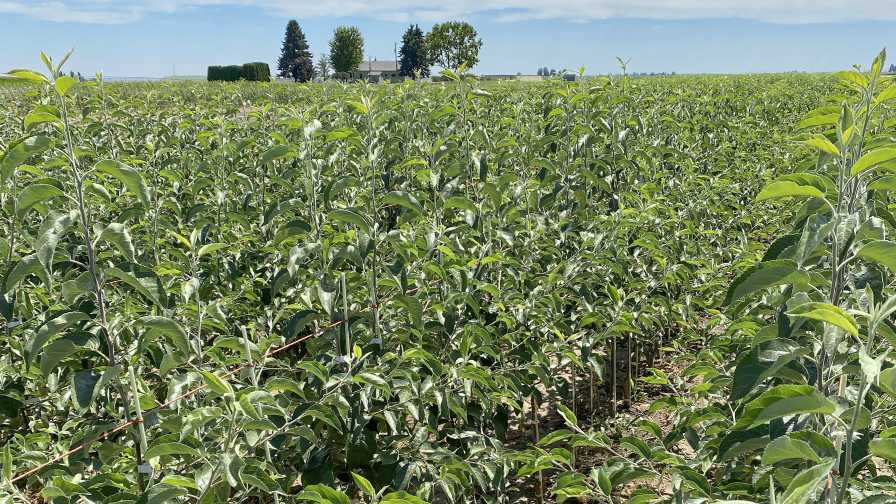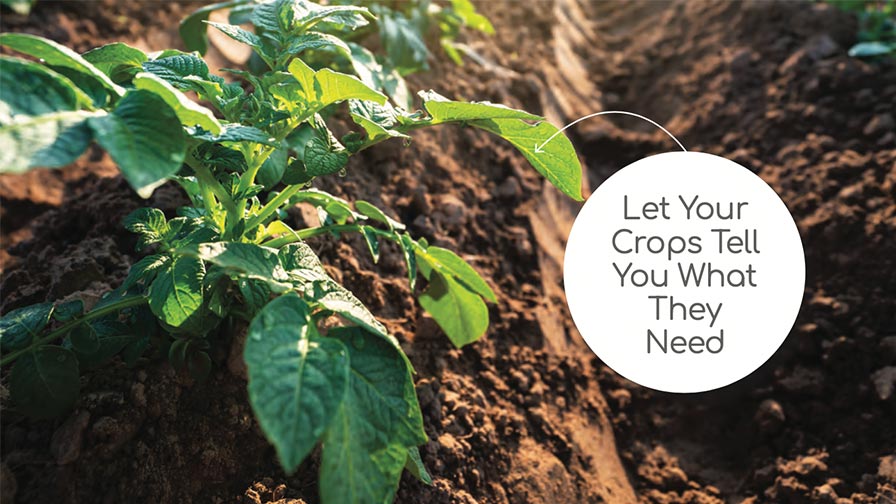Tree Fruit Nursery Industry Takes a Breath

This photo, taken in July, shows a nursery planting slated for 2021 of ‘Cosmic Crisp’ WA38 cv. USPP 24,210/Geneva ‘G.890’ US PP23,327 interstem apple trees.
Photo by Todd Cameron
It’s a unique time to be in the nursery business, says Todd Snyder of C&O Nursery in Wenatchee, WA, and that was before the pandemic.
“Actually, before COVID hit, we saw that many people weren’t placing advance orders as they did in the past,” he says. “Growers were slowing down to wait and see. We were not alone (among nurseries) in that.”
One big factor for Washington growers was the experience with ‘Cosmic Crisp’, a Washington State University apple variety available to only growers in the state.
“Our state was so enamored with ‘Cosmic’ — numbers you don’t see when you’re trying out a new variety were happening with ‘Cosmic’. The numbers going into the ground were very large. But when it came to picking and marketing, people wanted to wait and see if it worked before they continued to plant it in such large numbers,” he says. “So ‘Cosmic Crisp’ is still planted but not in the same numbers as in past.”
Of the growers hitting the pause button, Snyder says, “I understand it. I just don’t want it as a business model. Every time growers push back decisions, it pushed back decisions for us. Most of the nurseries are waiting for growers to make their move.”
Tom Burchell of Burchell Nursery in Oakdale, CA, has seen similar impacts on growers from COVID-19.
“It has made them more conservative when deciding to plant,” he says. “Of course, there are a lot of things people are wondering about right now, from the price of the commodity to the upcoming election.”
Still, other nursery experts say additional factors have played a more critical role. For example, Todd Cameron of Cameron Nursery in Eltopia, WA, says COVID’s impact has been minor.
“Probably less than export and strong-dollar issues,” he says. “Planting an orchard is a long-term investment.”
Sarah Paris, Research and Product Development Manager at Fowler Nurseries, Newcastle, CA, says the coronavirus has had more of an effect on production than labor.
“For example, during budding, a team of two employees work together to insert the bud into the rootstock and quickly tie the bud in place,” she says. “The two individuals typically work in close proximity to one another, but the pandemic has prompted us to strike a unique balance between increasing physical distance within our teams for their safety while ensuring the newly inserted buds don’t desiccate while waiting to be tied in place.”
In other words, the pandemic has heightened awareness of a problem quickly emerging in the nursery business: a labor shortage. Burchell says it’s akin to that faced by the growers as highly skilled people are aging out of the workforce.
“A lot of producers are going more into mechanization, but it’s tough to mechanize the budding process at the nursery,” he says. “We don’t have as many mechanization options. You’ve seen robots picking apples, but you haven’t seen any budding trees.”
Here are a few more questions fielded by nursery experts:
WHAT IS THE MOST PRESSING NEED GROWERS HAVE IN REGARD TO VARIETY SELECTION AS WE HEAD INTO 2021?
Brent Burky, Director of Sales, Sierra Gold Nurseries, Yuba City, CA: Arguably just as important as variety timing has been access to new varieties. Breeding programs are becoming more and more selective with who they choose to partner with. So progressive growers are going to start to have to take it upon themselves to become more aggressive and make sure the warehouses they work with are looking at new varieties and working with breeding programs to develop new varieties.
Cameron: Being ready with site and knowledge to grow ‘Honeycrisp’ with high production and good packouts. Its price has held very high in spite of rapid expansion in production, while mainstream varieties are treading water. If you are a great ‘Honeycrisp’ grower, you probably should keep planting as long as you can get them picked. Remember, ‘Gala’ was “over planted” in the early 90s.
WHAT IS ONE THING THAT GROWERS SHOULD (BUT MIGHT NOT) KNOW ABOUT THE NURSERY INDUSTRY?
Noah Tarry, Market Development Specialist, Dave Wilson Nursery, Hickman, CA: The amount of labor that goes into growing varieties in the nursery is extensive. From weeding to fertilizing, we handle trees with care — sometimes as many as 14 times before they are delivered to the grower. We are continually expanding and, as a result, our labor demands are also constantly increasing.
Cameron: You have to grow it, get it packed, and then sell it. And get all three right. The nurseries will not be buying your apples. The marketing desks and packers are closer to the buyers. The nurseries are more helpful with site-specific “grow it” advice on which selection or variety will suit the grower’s region and site.
Paris: The vast majority of our propagative material comes from our state-certified orchards. This is one way we ensure “clean” trees for our growers. To maintain this certification, we submit leaf samples from both rootstock and scion sources to CDFA (California Department of Food and Agriculture) on a yearly basis for testing of regulated viruses.
Burky: Things are changing constantly in the variety game. You have to move to the latest and greatest or risk losing your competitive edge. Many nurseries are not offering the best variety selection available, so you have to be careful and do your homework before you commit to a major long-term investment. Not every nursery has access to new and improved selections, so ask around and make sure you are exploring all your options. You want to partner with a nursery that has access to the varieties you want, not the other way around.
AS WE LOOK FURTHER OUT, WHAT ARE THE NEXT CHALLENGES THAT NEED TO BE ADDRESSED THAT
YOU WILL BE FOCUSED ON?
Paris: Fowler Nurseries, as part of Progressive Genetics Group, will continue to plant experimental rootstocks and varieties from international breeding programs in the orchards of our most progressive growers. These rootstocks and varieties have the potential to achieve some important industry goals, including semi-dwarfing rootstocks to help facilitate off-ground harvest as a way of reducing dust during harvest.
Burky: At Sierra Gold, we have been focused on leveraging our on-site tissue culture lab, our greenhouse infrastructure, and our ellepot container systems to produce nursery products with a faster turn from order time to delivery. This way, growers can make later choices of scion/rootstock to match market conditions. Growers cannot afford to wait one to three years for the right variety on the right rootstock.









